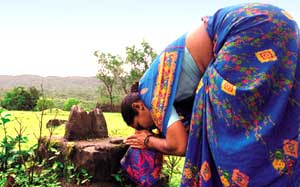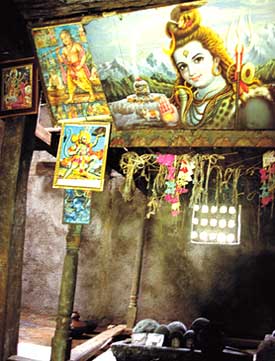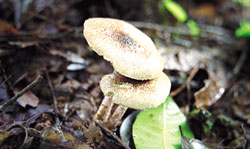GROUNDFACTS | MAHARASHTRA
Ahupe is a tiny village in the Mahadev Koli tribal area of Pune district in Maharashtra. Its residents are armed with a mission. Ten young villagers have started documenting the biodiversity in their grove. "A lot of people keep coming here. They all seem to be interested in the trees and plants that grow in the grove. This used to intrigue us. What is it that attracts so many educated people here?" says Dharma Lokande, a primary school teacher, "So we started keeping records of the local trees and plants. Our ultimate aim is to prevent outsiders, especially pharmaceutical companies, from taking advantage of our ignorance." Very often, the concept of the sacred is disassociated from the idea of reverence and instead becomes a canon for protection. Some groves may be protected, in a physical sense, but its custodians forget to mend the communities’ social ties that have been breached. Sometimes, the only way this can be done is by rationalising the sacred. Residents of Ahupe village are doing just that. Pharmaceutical companies are one possible threat. But the laws of the land are a more immediate and pressing menace. There are 2,808 sacred groves covering nine agro-climatic zones across Maharashtra, of which 1,849 cover less than 1 ha of land while only two are greater than 100 ha. In local parlance, they are called devrahis or devrathis. Ownership, rituals, social sanctions and management practices in these groves vary from place to place.
Traditionally, these groves were community-owned and treated as social assets. Today, groves are owned either by individuals or first settling clans, or by the state forest department. Some groves are also owned and maintained by the Paschim Maharashtra Devasthan Samiti (See "How not to manage groves"). In 1975, the Maharashtra Private Forests Acquisition Act brought large patches of forest under government rule. Section 35 of this Act deals with the transfer of sacred groves greater than 12 ha from individual or community ownership to the forest department. This act declares community-held forests as illegal holdings. It also states that all other forest land less than 12 ha and not privately owned will come under the forest department. Community-owned groves have suffered the most. Maharashtra’s land-holding policies force villages to record land in the name of individuals. As a solution, in most cases, the village priest, who is a non-Brahmin member of the upper caste, is named the custodian of the grove. In the eyes of the law, he is its owner. But only legally. Arjun Hira Katkar, one such owner, says, "The villagers suggested that I register the Bharandi Devi sacred grove in my name otherwise the government would have taken it over, leaving the villagers with very little stake in it. Now I hold the grove on behalf of my community and we all share its resources." Despite individual ownership, for all practical purposes, these groves may count as common property resources or local common resources (those that are common to some communities but not accessible to others). Some groves are still owned by the earliest-settling clans or families. The Satichamal grove near the Kolhapur-Sindhudurg highway was created 30 years ago. Legend has it that during the construction of the road, a local labourer Dondhu Jaktap became an ardent follower of a saint and his wife who lived in the forest nearby. After the saint died and his wife committed sati, Jaktap created a sati shrine in her honour, establishing the sacred grove and its associated village. Some years later, tribal communities from the Dajipur sanctuary were relocated to Satichamal village. But the grove still belongs to the Jaktaps as they were the first settlers and also because their family burial ground is located there. This is where Dondhu Jaktap lies buried. The grove contains a few acacia trees and a small shrine. During the shimgha or holi festival, the whole village congregates in this grove to offer prayers to the deity.
Time for priorities Traditionally, sacred groves housed memorials of the dead. Over the years, modern temples have come up inside them. These temples, with their Hindu gods and goddesses, attract more followers today. Tivri village in Ratnagiri is a typical case. Its sacred grove has been relegated to a small patch of 0.2 ha. It contains a modern temple dedicated to Bajikedar, or Lord Shiva. The Bajikedar mandir looks like any other modern temple, with a large tiled-floor hall filled with icons of gods and goddesses, adorned with lamps and fresh flowers. It is only the sides of the temple that are decorated with the traditional tavada gods, who are represented as small monolithic structures that bear no resemblance to their neighbouring Hindu gods. The temple premises are full of round stones that mark the original burial sites. Outside the temple gates are found the relatively modern burial grounds with structures that have Sanskrit writings on them. Because of the prominence given to the Hindu gods and goddess, the grove has turned into an institution of Hinduism. Temple priest Babu Ramchandar Gaurav says, "Earlier, members of all communities and religions used to visit our grove. Now Buddhists and Muslims do not come anymore. The Buddhists, who were previously dalits, also had their own sacred groves. Those, however, do not exist any longer." This situation is not unique to Tivri alone. Everywhere in Maharashtra, it appears that people belonging to other communities are consciously staying clear of sacred groves because they perceive them to be representations of Hinduism. This has certainly reduced the scope of a sacred grove as a cultural and social community space. Ecological bountyThe groves provide tremendous resources to the communities, which in earlier times would not have been so integrated into the larger economy. A number of villages have more than one grove, and each has a different role to play. A look at the prevailing systems of prudence in some existing (or barely surviving) groves helps one redraw a picture of how these institutions may have worked in the past. Felling of timber is a taboo in most groves. However, the community can use twigs, leaf litter, fruits and herbs that grow in them. In Devrahi Vadi, members of the community come together before the sowing season to offer prayers to Bhagoba Devi and seek her permission to remove twigs and leaf litter from the grove. These are used as manure in the paddy fields. In the masutias (burial grounds), fuelwood is collected from the grove only to cremate the dead. The Mahadev Kolis of Maharashtra follow slash and burn cultivation. The sacred groves are the only piece of forest in their area that is kept untouched. The topsoil from the groves is used as manure to cultivate millets and sesame. Sacred groves are also storehouses
of medicinal plants. The nataknar tree is found only in the Brahmari Rahi sacred
grove and nowhere else in the adjoining forests. Its leaves have medicinal properties that
cure stomach disorders in cattle. The tuber from its saplings is fed to the cattle to
increase their appetite. Gometi (melothria heterophylla) is an edible
mulberry that is very popular among local children. Thorny creepers such as the gondvil
(chloris barbata) are used to cure mouth ulcers in cattle. The villagers insert a
thorny creeper into the cow’s mouth. It then serves a dual purpose. The thorns
rupture the ulcer while the plant juices cure the wound in no time. Karnavand or carissa carandas is commonly found in the Kolhapur and Konkan belts. Its roots and flowers are used to treat stomach disorders, scabies, skin diseases and intermittent fever. The sitecha ashok is commonly used for pimples and dipsia. Katal jasvand is one of the most popular medicinal plants found in the sacred grove. Its tuber is used to cure joint pains. The villagers need not go far for their spices either. Many flowers and seeds from the grove add to the flavour of the local Konkani cuisine. Small white flowers from the chirpal tree or zanthoxylum rehetsa are dried and used as spices. The groves are also home to chitlea, small edible mushrooms that are a delicacy in the Konkan. Like community kitchen gardens, Maharashtra’s sacred groves harbour 1,040 different species of plants. "It is not as if these plants are not found elsewhere in the adjacent forests. We depend on the devrahis for these medicines because they are easily accessible," says a local villager. Changing dynamics Over the years, villagers working in big cities like Mumbai have donated money to construct a large temple. Women and dalits are not allowed entry in its sanctum sanctorum. The sacred grove also has mandaps (platforms) where cultural events take place during the festival season. "We collect Rs 10,000 to 15,000 from the villagers to organise cultural programmes in these groves," says a local villager. The grove, a common forest space, has now become a commercial cultural space. The "sacred" barely survives the wrath of the gods of a new economy but the groves are long gone. Are these secular icons of yesterday powerful enough to save the forests of tomorrow? |
||||||||||
|



